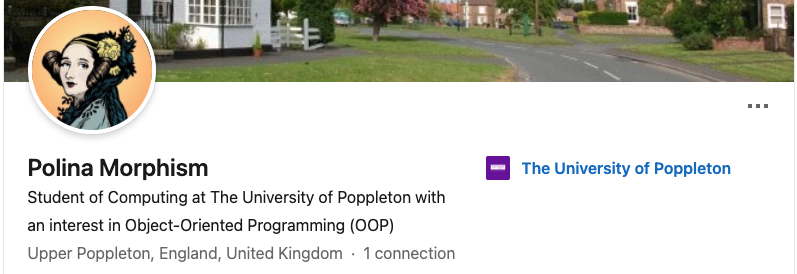9 Hacking Your Future
It’s very easy to overlook mistakes in your own writing because its difficult to be both an author and an editor of the same text. That’s true of any written communication such as a covering letter, personal statement, email, essay or any message that you write. Mistakes are particularly common in CVs (or résumés) because they are so personal. You can spend hours carefully polishing the words and the formatting but not see a fatal error at the top of page one. Hacking26 other people’s CV’s will help you debug and improve your own. You may need to use ingenious hacks like the temporary fix to the bridge in figure 9.1. Fixing other peoples bridges will help you improve your own bridge, see section 0.5.1. You’ll build better bridges to more interesting and ambitious destinations.

Figure 9.1: Your CV is a bridge which enables you to cross from where you are now to where you’d like to be in the future. Like the bridge in this picture, the CV’s in this chapter are all faulty in some way, can you fix them? You may need to use ingenious hacks and kludges like the one shown here on the Million Dollar Bridge in Alaska . Public domain image of kludgy repairs adapted from an original by Jet Lowe on Wikimedia Commons w.wiki/3Uvn
Your future is bright, your future needs hacking, so let’s start hacking your future.
9.1 Hacking their futures
Hacking other people’s code is a good way to learn how to code. Hacking other people’s CV’s is a good way to learn how to write better CVs too. The dogfooding technique described in section 4.6.1 is a useful hack which you can use by:
- Eating your own dogfood by reading your own written work ALOUD
- Eating somebody elses dogfood by:
- Eating your own dogfood again, re-reading and re-editing repeatedly
- Persuade someone else to eat your dogfood - get feedback from as many people (and bots see section 8.8.8) as you can
So, here are some fictitious CVs for you to hack, from students of Computer Science. They are based on CVs I’ve seen, warts and all, with personal information removed and anonymised. Can you spot their triumphs and tragedies? Can fix their CVs and work out which candidate is best for the sample job description at CoolTech in section 9.4? Can you hack their future?
Special thanks to Toby Howard and Sean Bechhofer for coming up with some of these silly fictional names for the late arrivals at the Computer Science ball. (Lyttelton, Cryer, and Dee 1972) Please direct any complaints about the terribly geeky puns and in-jokes to Toby and Sean! Can you spot all the bad jokes? Thanks also Ben Carter and Penny Gordon Lanes in the Careers Service at the University of Manchester, some of these CVs are based on examples they have collected and anonymised. 🙏
9.2 Breakpoints
Let’s pause here. Insert a breakpoint in your code and slowly step through it so we can examine the current values of your variables and parameters.
When you read these CVs make a note of:
-
What Went Well? (
WWW) What do you like about any given CV, what have they done well? -
Even Better If? (
EBI) What could be fixed or improved, can you hack it? -
Their Rank order (
1,2,3...) Who is top of your list to interview? Who is going in the bin and why?
Imagine the person is real, what would you tell them about their CV if they’d given it to you for advice without hurting their feelings? How could you be a critical friend by giving them actionable feedback?
9.3 Sample CVs
Hacking other people’s CVs will help you improve your own because you’re putting yourself in the shoes of your reader. Here are some samples:
9.3.1 Penelope Tester
Penelope Tester, or Pen as her friends call her, loves cybersecurity and reverse engineering. She has a real passion for finding vulnerabilities in software and hardware. Just don’t call her a hacker she dislikes that word, see figure 9.2.

Figure 9.2: Penelope Tester’s full CV can be viewed at cdyf.me/Penelope_Tester.pdf
9.3.2 Rick Urshion
Rick is a big fan of functional programming and loves solving problems with languages like Lisp, Haskell, Clojure, Erlang and Scala. He really doesn’t like side-effects but tries to avoid getting into a state about it. Critics say he can be inefficient but Rick insists he’s just lazy, see figure 9.3. Rick’s father and grandfather were also called Rick, and his great-grandfather was too. You’ll never guess what Rick and his partner are going to call their son…

Figure 9.3: Rick Urshion’s full CV can be viewed at cdyf.me/Rick_Urshion.pdf
9.3.3 Marge Conflict
Marjorie loves version control because Marge is the master of the merge. She also has very high emotional intelligence (EQ), a superpower that enables her to recognise emotions in herself and others so that she can quickly resolve people’s inevitable differences, see figure 9.4.

Figure 9.4: Marge Conflict’s full CV can be viewed at cdyf.me/Marge_Conflict.pdf
Resolving people’s differences is an important skill, not just for git merge shown in figure 9.5, but any kind of team collaboration where some kind of conflict is inevitable.
9.3.4 Michael Rokernel
Mike lives in Los Angeles and loves operating systems, but not if they get too bloated, see figure 9.6.

Figure 9.6: Mike Rokernel’s full CV can be viewed at cdyf.me/Mike_Rokernel.pdf
9.3.5 Florence Ting-Point
Flo loves maths and is a particularly big fan of floating-point arithmetic, see figure 9.7.

Figure 9.7: Flo Ting-Point’s full CV can be viewed at cdyf.me/Flo_Ting-Point.pdf
9.3.6 Peter Byte
Peter Byte and his twin sister Peta Byte, both love big data, machine learning, statistics, data science and Artificial Intelligence (AI). They come from a big family with eleven other siblings including Deca Byte, Hector Byte, Kilo Byte, Megan Byte, Giga Byte, Terry Byte, Exa Byte, Zita Byte, Yotta Byte, Rona Byte and Quetta Byte. The Bytes are highly trained27 and wildly ambitious. (Benaich et al. 2023) Critics say the Byte family have been terribly over-hyped, don’t explain themselves properly and can’t distinguish between truth and falsehood. (Metz 2023b) Critics also point out that the Bytes are unsustainable, both environmentally and socially. (K. Crawford 2024; Perrigo 2024) You’ll have to judge for yourself in figure 9.8.

Figure 9.8: Peter Byte’s full CV can be viewed at cdyf.me/Peter_Byte.pdf
9.3.7 Polina Morphism
Polly loves object-oriented programming. She has lots of siblings, and a cousin called Isa. Instead of a CV or résumé, Polly has put some basic details on her LinkedIn profile which she primarily uses for professional social networking, see figure 9.9.

Figure 9.9: A pdf of Polina Morphism’s LinkedIn profile can be found at cdyf.me/Polly_Morphism.pdf, the original can be found at linkedin.com/in/pollymorphism (you may be asked to login to see her profile)
9.3.8 Neil Pointer
Neil is a mature student who loves the C programming language, see figure 9.10. He’s a member of the sometimes misunderstood Pointer family, which Neil compensates for with his excellent memory management skills and efficiency. As well as twin sister Noelle, he also has three famous sisters, (Pointer, Pointer, and Pointer 1984) and a younger half-brother, Neil Pointer-Exception (who prefers Java), from his fathers second marriage. Noelle and Neil Pointer have seen many programming languages come and go, but their favourite will always be C. Like C, Neil and Noelle are children of the 1970s, easily “old enough to be your father” or (in Noelle’s case) your mother. Respect your elders! (D. M. Ritchie 1993)

Figure 9.10: Neil Pointer’s full CV can be viewed at cdyf.me/Neil_Pointer.pdf
9.3.9 Bryn Hanby-Roberts
The last CV is a real one. Bryn kindly gave his permission to share it with you, see figure 9.11. Bryn graduated in 2016, his CV is longer as he has five years of experience under his belt but it provides a useful counterpoint to the examples above. Thanks Bryn. 🙏

Figure 9.11: Bryn Hanby-Roberts full CV can be viewed at cdyf.me/bryn.pdf a snapshot taken in 2021 from bryn.co.uk
9.4 Sample CoolTech Job advert
We’re looking for bright and geeky graduates to join our software engineering team. No experience is required, and many of our successful applicants have never programmed before. If you think logically and enjoy problem solving, then you have the potential to become a great developer.
A career at CoolTech will challenge you every day. In your first few weeks you will be solving real-world problems as you help to develop software used by professionals across the world.
You’ll be part of an agile development team, working on one of the largest real-time databases in the world. You’ll work on a wide variety of projects, ranging from Artificial Intelligence assisting clinicians with early diagnosis of cancer to an iOS app helping patients manage their diabetes.
Developers at CoolTech are involved in the full software cycle, and work closely with all teams across the company to scope out new projects as they design, develop and deploy our products.
9.5 Summarising Your Future
Too long, didn’t read (TL;DR)? Here’s a summary:
Your future is bright, your future needs hacking. Hacking your future will help you to test your future by debugging your own CV. Testing your future will help you to start coding your future, see figure 9.12

Figure 9.12: Once bugs have been identified on your CV, you’ll need some workarounds. They might be kludges: quick-and-dirty workarounds that are clumsy, inelegant, inefficient, difficult to extend and hard to maintain. Or they might be more elegant and ingenious hacks. Either way, fixing bugs on your own CV, and other people’s CVs, will improve your chances of being invited to interviews. Public domain image of kludgy repairs to the Million Dollar Bridge in Alaska adapted from an original by Jet Lowe on Wikimedia Commons w.wiki/3Uvn adapted using the Wikipedia app
So:
- Reading other people’s code will help you write better code yourself
- Reading other people’s CVs helps you write a better CV yourself
- The more you read, the better you get at writing
So, after you’ve compared the CVs above to your own, find a critical friend and do a CV swap, see section 8.11. You will both benefit by putting yourself in the shoes of your reader.
In the next part, chapter 10: Verbalising your Future we’ll look one more debugging technique, paying attention to the verbs on your CV and what they say about you.
